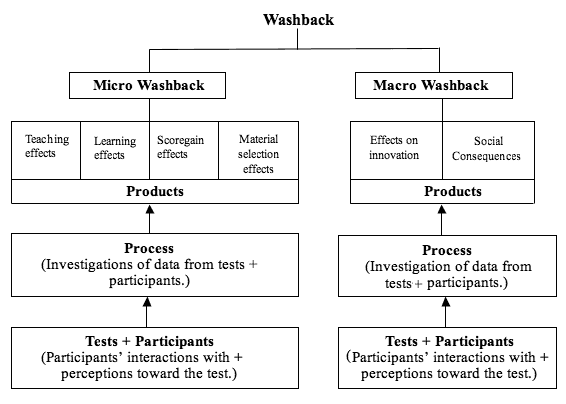| Studies: |
Shohamy, et al. (1996) |
Alderson & Hamp-Lyons (1996) |
Cheng (1999) |
Green (2007) |
Shih (2007) |
| Exams studied: |
An Israeli ASL test & ESL test |
TOEFL® |
Old & New HKCEE |
IELTS Writing Test |
GEPT |
| Purposes: |
To examine the impact of 2 national tests in and beyond classroom settings |
To ascertain influence of the TOEFL on class teaching |
To compare teachers' perceptions toward both exams |
To examine how preparation classes impact score gains |
To explore the effects of GEPT exit requirements on learning |
| Methodologies: |
1. Student questionnaires
2. Structured interviews with teachers and inspectors
3. Analysis of inspectorate bulletins |
1. Interviews with teachers and students
2. Classroom observations |
1. Teacher/student questionnaires
2. Structured interviews with teachers
3. Classroom observations |
1 . Two IELTS writing tests
2. Two questionnaires consisting of participant and process variables respectively |
1. Interviews with department heads, teachers, students, and family members
2. Classroom observations |
| Collected evidence: |
1. More positive washback found in ESL
2. More negative washback found in ASL |
1. More occurrences of teacher talk, the use of meta language in non-TOEFL classes
2. Fewer opportunities for pair work, laughter, and turn-taking in TOEFL classes |
1. An increased change in teaching content and activities
2. A lack of change in teaching methodologies |
An improvement in test scores for learners in test-preparation or academic-oriented classes,
but those in the former progressed no more than those in the latter |
1. Small but varied aspects of washback found in students at both schools with and without exit requirements
2. External, intrinsic and test factors explain GEPT's minor impact on students' learning |
| Conclusions: |
Washback changes over time because of factors including language status and test uses. |
TOEFL affects both what and how teachers teach, but the effect varies with teachers. |
The change on teaching content rather than methodology was attributed to inadequate training and
qualifications of secondary English teachers. |
Test preparation classes have no apparent benefit to improve test scores. |
The current washback theory didn't account for GEPT washback, so a new learning
washback model has been developed. |


 PDF Version
PDF Version

